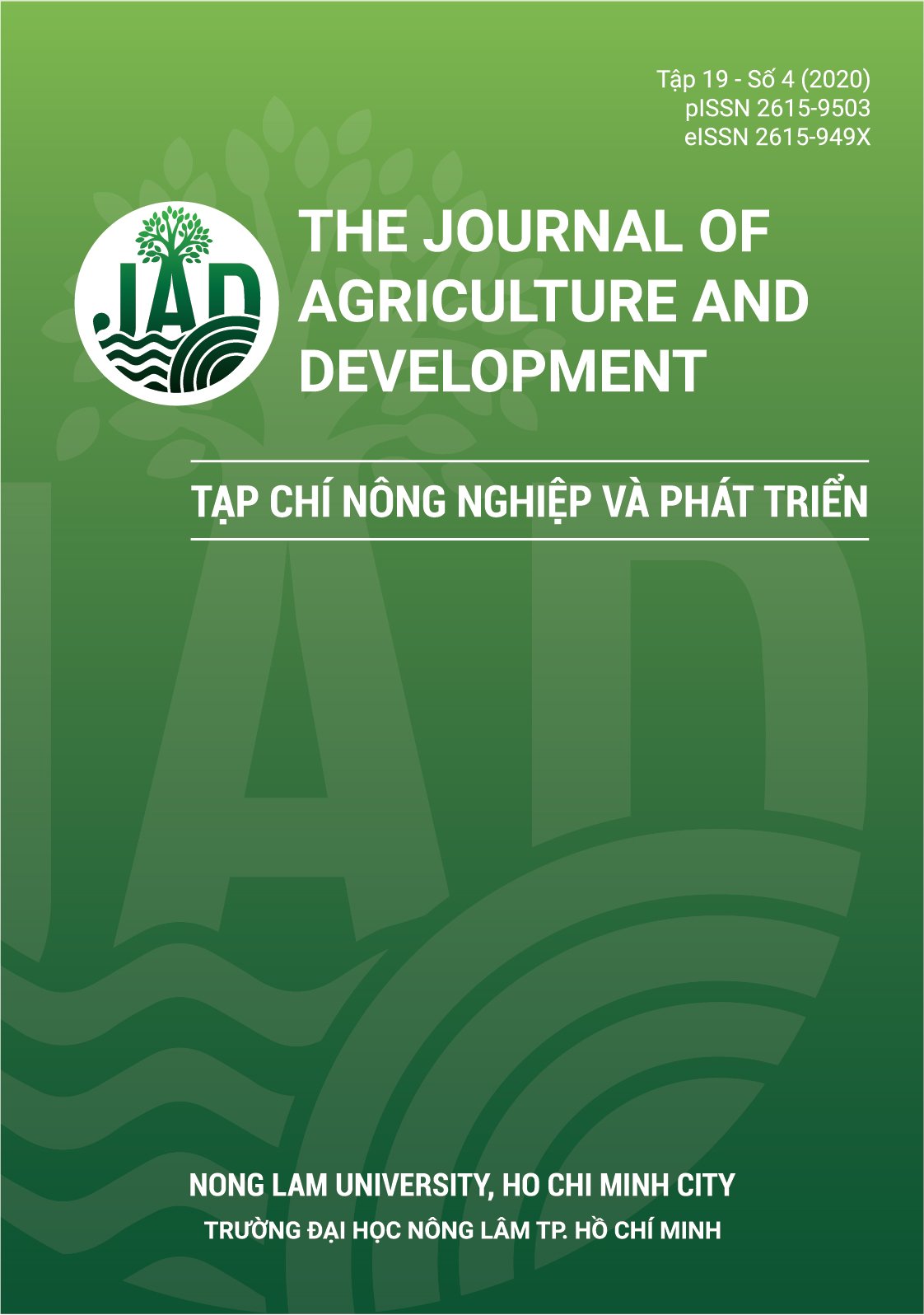Effect of nitrogen levels on growth and development of three Lisianthus (Eustomagrandiflorum(Raf.) Shinn) cultivars pot-planted in Ho Chi Minh City
Main Article Content
Abstract
Lisianthus (Eustoma grandiflorum (Raf.) Shinn) is favored in deco-ration because of its long-lasting and colorful flowers. The objectiveof the experiment was to evaluate the effects of different levelsof nitrogen on the growth and development of three Lisianthuscultivars pot-planted in Ho Chi Minh City. The experiment was laidout in split - plot design (SPD) with four levels of nitrogen (3; 4; 5;6 g/pot) being the main factor and three lisianthus cultivars (Pink;Yellow; White/Purple) being the subordinate factor. Each pot wasplanted with one plantlet. The results indicated that plants appliedwith 4.0 g nitrogen per pot gave the best performance in plantheight (18.41 cm) and number of leaves (24.08 leaves/plant) at 60days after planted (DAP). The Pink cultivar reached the highestplant height (19.92 cm), number of leaves (43.53 leaves/plant)as well as number of flowers buds (12.31 buds/plant). The Pinkcultivar, when applied with 4.0 g nitrogen/pot, gave the highestplant height (21.38 cm) at 60 DAP.
Article Details
References
Ahmad, H., Rahul, S. K., Mahbuba, S., Jahan, M. R., & Uddin, A. F. M. J. (2017). Evaluation of Lisianthus (Eustoma grandiflorum) lines for commercial production in Bangladesh. International Journal of Business, Social And Scientific Research 5(4), 156-167.
Asen, S., Griesbach, R. J., Norris, C., & Leonhardt, B. (1986). Flavonoids from Eustoma grandiflorum flower petals. Phytochem 25(11), 2509-2513. https://doi.org/10.1016/S0031-9422(00)84498-2
Harbaugh, B. K., Bell, M. L., & Liang, R. (2000). Evaluation of forty-seven cultivars of Lisianthus as cut flowers. Hort Technology 10(4), 812-815. https://doi.org/10.21273/HORTTECH.10.4.812
HCMCPC (Ho Chi Minh City People’s Committee) (2016). Decision No. 536/ QD-UBND February 5, 2016 on approving the flower growing program in the city in the period of 2016 - 2020. Ho Chi Minh City, Vietnam: Ho Chi Minh City People’s Committee.
Jafari, R., Moieni, A., Karimzadeh, G., & Movahedi, Z. (2017). In Vitro Propagation of Lisianthus (Eustoma grandiflorum). Journal of Plant Physiology and Breeding 7(2), 53-65.
Kunitake, H., Nakashima, T., Mori, K., Tanaka, M.,& Mii, M. (1995). Plant regeneration from meso- phyll protoplasts of lisianthus (Eustoma grandiflorum) by adding activated charcoal into protoplast culture medium. Plant Cell, Tissue and Organ Culture 43, 59-65. https://doi.org/10.1007/BF00042672
LDPPC (Lam Dong Province People’s Committee) (2012). Decision No. 1251/QD-SNN dated December 13, 2012 on temporarily cultivation procedures for some local crops in Lam Dong Province. Lam Dong Province, Vietnam: Lam Dong Province People’s Com- mittee.
Le, V. D. (2006). Curriculum for soil fertility and fertilizer. Nong Lam University, Ho Chi Minh City, Vietnam.
Mengel, K., Kirkby, E. A., Kosegarten, H., & Appel, T. (2001). Principles of plant nutrition. NewYork, America: Springer Nature Switzerland AG. https://doi.org/10.1007/978-94-010-1009-2
Nguyen, C. C, Bui, T. C., Nguyen, L. D., & Le, T.L. (2019). Effect of substrates and floria fertilizer on growth and development of Lisianthus (Eustoma grandiflorum) pot-planted in Ho Chi Minh City. Report on scientific research topics, Nong Lam University, Ho Chi Minh City, Vietnam.
Popa, G., Balan, V., & Plocon, C. (2004). Studies on the in-vitro culture of Lisianthus russellianus Hook. Buletinul Universitatii de Stiinte Agricole si Medicina Veterinara Cluj Napoca Seria Zootehnie si Biotehnologii 60, 319-322.
Rayment, G. E., & Lyons, D. J. (2011). Soil chemical methods - Australasia. Victoria, Australia: SCIRO Publishing.
Slavich, P. G., & Petterson, G.H. (1993). Estimating the critical conductivity of saturated paste extracts from 1:5 soil:water suspensions and texture. Australian Journal of Soil Research 31(1), 73-81. https://doi.org/10.1071/SR9930073








